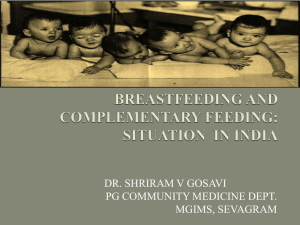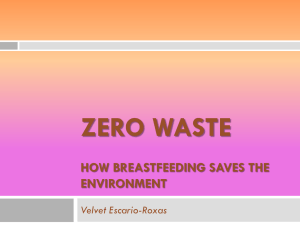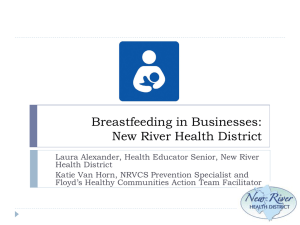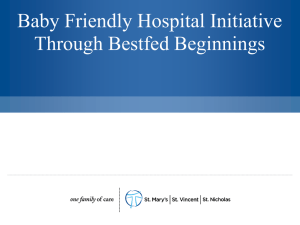Breastfeeding Performance Improvement: Using
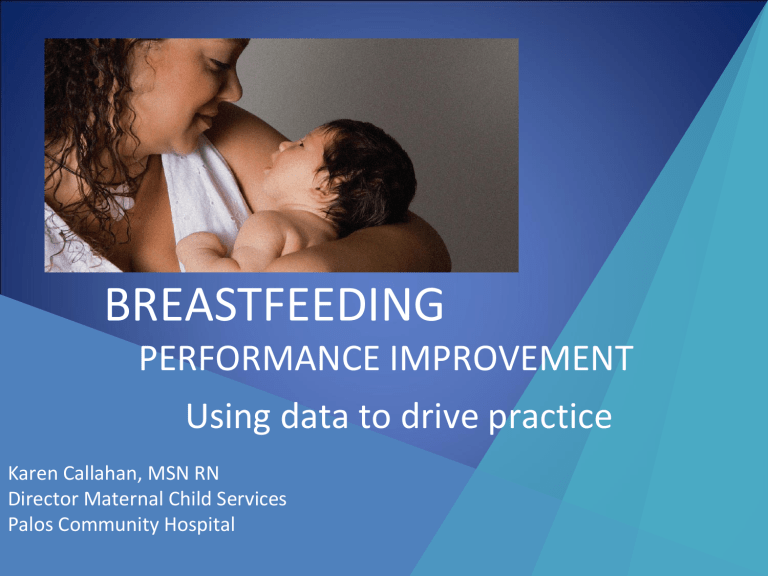
BREASTFEEDING
PERFORMANCE IMPROVEMENT
Using data to drive practice
Karen Callahan, MSN RN
Director Maternal Child Services
Palos Community Hospital
Palos Community Hospital
• 26 bed LDRP Unit
• Level 2 ICN
• 1200 births per year
• 2.5 FTE Lactation Consultants IBCLC
• 4 new CLCs working 3p-7a
• Nursing Moms Network Breastfeeding Support Group
• Pump Rental & Lactation Boutique
• Centricity Perinatal for L & D charting
• Meditech for Post partum and Newborn charting
Timeline Breastfeeding PI Project
2010-2011
Exclusive breastfeeding TJC Core Measure
• Actions: The exclusive breast feeding core measure from the Joint Commission added as a quality indicator for MCH nursing and Pediatric medical PI.
• Newborn feeding methods were developed in
Meditech Patient Care System (PCS).
• Newborn standing orders were revised to include reasons for supplementation.
• Exclusive breastfeeding core measure is monitored monthly by the Quality Analyst and Lactation
Consultants monthly.
• Nursing outlier cases are peer reviewed by the Unit
Based Practice Council.
Timeline Breastfeeding PI Project mPINC Survey Results returned
Action Plan developed
• Skin to skin contact and initial breast feeding within 1 hour of vaginal birth and within 2 hours of c-section.
• The golden hour initiative implemented
December 2010 for initiation of breastfeeding and skin to skin contact. Within 1 hour of a vaginal delivery and 2 hours of a c- section, skin to skin contact for 30 minutes. Skin to skin becomes standard of practice.
GE Centricity Perinatal
Labor & Delivery Summary
• Feeding preference documented
Breastmilk
Formula
Pump
Undecided
• Golden Hour Initiative
Skin to skin 30 minutes within 1 hr of vaginal delivery
Skin to skin 30 minutes within 2 hrs of C-Section
Initiate Breastfeeding within 1 st hr post delivery
Meditech Assessments
Meditech EMR
Meditech Assessments
Meditech Assessments
65%
60%
Breastfeeding Rates at PCH
Breastfeeding Initiation Rate 2000-2011
85%
80%
75%
70%
82% 82% 82%
82% 82% 82% 82% 82% 82% 82%
82%
79%
79%
75% 75%
76%
76%
74%
71%
72%
69%
71%
HealthyPeople 2020 Goal
% breastfeeding
Линейная (% breastfeeding)
MONTHLY STATISTICS
NEWBORN ADMISSIONS*
IDENTIFIED BREASTFED NEWBORNS
EXCLUSIVELY BREASTFED
Dec-
10
Jan-
11
Feb-
11
Mar-
11
Apr-
11
May-
11
Jun-
11
Jul-
11
Aug-
11
Sep-
11
Oct-
11
Nov-
11
Dec-
11
TOTA
LS
72
48
16
87
74
22
97
73
23
90
75
30
79
58
22
111 112
85
32
84
38
109
82
38
120
95
35
89
75
32
98
73
39
83
63
31
% OF EXCLUSIVELY BREASTFED 33% 30% 32% 40% 38% 38% 45% 46% 37% 43% 53% 49%
DOCUMENTED REASONS FOR NOT EXCLUSIVELY BREAST FEEDING
<37 Completed weeks of gestation
Discharge from the hospital while in SCN
Dehydration/10% Weight loss
Patient Request
2
1
4
14
0
1
1
23
0
1
0
29
0
2
2
2
0
0
1
6
16
1
3
5
37
0
1
5
25
2
0
6
28
3
1
6
40
0
0
6
29
0
0
7
21
0
2
9
12
13
1
6 12 7 14 5 7 6 3 9
Other Documented Reason for Not Exclusively
Feeding Breast Milk 5
REASONS FOR OPPORTUNITY FOR IMPROVEMENT
17
Mother Requested Supplementation & No Physician Order
No Physician Order for Supplementation
2
4
4
6
5
2
3
2
0
1
0
0
0
1
2
1
2
1
1
1
0
3
0
0
114
19
22
0
0
0
8
13
57
294
1147
885
358
40%
Exclusive Breastfeeding at Discharge
12/2010-11/2011
60
50
40
30
20
33
30 32
40 38 38
45 46
37
43
53
49
% Exclusively Breastfed
HP 2020 Goal
Linear (% Exclusively
Breastfed)
10
0
Dec Jan Feb Mar Apr May Jun Jly Aug Sep Oct Nov
Month
Percent reason for not Exclusively Breastfeeding 12/2010 - 11/2011
70
60
50
40
30
20
10
0
2 3
12
60
< 37 weeks gestation
Discharge from the hospital while in ICN
Dehydration/
10% Weight loss
Reason
Patient
Request
23
Other
Reasons
Percent
Multidisciplinary Breastfeeding
Committee
Committee will revise policy to include elements of breastfeeding practice identified by mPINC. Address Baby Friendly breastfeeding initiation, continuation and exclusivity strategies.
Task force members include representation from: MCH Nursing, OB, Pediatrics,
Neonatology, Nursing Administration,
Lactation and Quality Improvement.
What Can We Do
To Make a Difference?
Palos is in the Rush Perinatal
Network
The Rush Perinatal Network has established minimum standards for breastfeeding practice and a timeline for
2012
The Multidisciplinary committee will operationalize the minimum standards
Network Minimum Standards for
Breastfeeding Care
• Provide Skin to Skin Contact for at least 30 minutes to all patients without complications regardless of feeding method within 2 hours of delivery
• Initiate breastfeeding within 60 minutes for all uncomplicated vaginal and cesarean births
• Promote 24 hour rooming in to keep mothers and babies together unless medically indicated
• Facilitate breastfeeding on demand
Network Minimum Standards for
Breastfeeding Care
• Educate and promote patients and families on the benefits of exclusive breastfeeding
• Support exclusive breastfeeding by avoiding the use of routine supplementation of breastfeeding infants through the use of formula, glucose, or water unless medically indicated.
• For mothers who are separated from their babies educate and initiate breast pumping as soon as possible post delivery or within 6 hrs
EBBHI Project Timeline
2012
Complete Network Breastfeeding Practice Survey
1 st Quarter
Hospitals Identify Champions
Create a breastfeeding committee
Complete Baby Friendly Assessment
Report Baseline Quality Outcomes
Report Status
2 nd Quarter
Create a workplan
Breastfeeding policy development/revision
Report Status
EBBHI Project Timeline
2012
3 rd Quarter
Implement workplan
Educate staff and providers
Report Status
4 th Quarter
Report Monthly Quality Outcomes
Complete Network Breastfeeding Practice Survey
Report Status
Next Steps
Revise breastfeeding policy
Develop role of CLC
Implement skin to skin for c-section patients in OR
Champions to attend
HC One Rush Training
Feb 16, 2012

